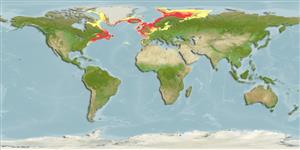Teleostei (teleosts) >
Gadiformes (Cods) >
Gadidae (Cods and haddocks)
Etymology: Gadus: Latin, gadus = a fish, cod? (Ref. 45335).
More on author: Linnaeus.
Environment: milieu / climate zone / depth range / distribution range
Ecology
Marine; brackish; benthopelagic; oceanodromous (Ref. 51243); depth range 0 - 600 m (Ref. 1371), usually 150 - 200 m (Ref. 54441). Temperate; 0°C - 15°C; 83°N - 35°N, 76°W - 86°E (Ref. 1371)
North Atlantic and Arctic: Ungava Bay in Canada along the North American coast to Cape Hatteras; North Carolina in the western Atlantic. East and west coast of Greenland; around Iceland; from Barents Sea including the region around Bear Island along the European coast to Bay of Biscay (Ref. 88171).
Length at first maturity / Size / Weight / Age
Maturity: Lm 65.4, range 31 - 74 cm
Max length : 200 cm TL male/unsexed; (Ref. 1371); common length : 100.0 cm TL male/unsexed; (Ref. 1371); max. published weight: 96.0 kg (Ref. 9988); max. reported age: 25 years (Ref. 173)
Dorsal spines (total): 0; Dorsal soft rays (total): 44 - 55; Anal spines: 0; Anal soft rays: 33 - 45; Vertebrae: 51 - 55. Protruding upper jaw, a conspicuous barbel on the lower jaw, and light lateral line, curved above the pectoral fins. Predorsal distance is less than one third of total length; body depth about 1/5 of total length. Color varies from brownish to greenish or gray dorsally and on upper sides, becoming pale and silvery ventrally. Peritoneum silvery.
Body shape (shape guide): fusiform / normal; Cross section: oval.
Widely distributed in a variety of habitats, from the shoreline down to the continental shelf. Juveniles prefer shallow (less than 10-30 m depth) sublittoral waters with complex habitats, such as seagrass beds, areas with gravel, rocks, or boulder, which provide protection from predators (Refs. 89383, 89384). Adults are usually found in deeper, colder waters. During the day, form schools and swim about 30-80 m above the bottom, dispersing at night to feed (Ref. 1371, 89385). Omnivorous; feed at dawn or dusk on invertebrates and fish, including young cod. (Ref. 1371). Migrate between spawning, feeding and overwintering areas, mostly within the boundaries of the respective stocks. Migrations >200 km are rare occurrences (Refs. 89386, 89387). Marketed fresh, dried or salted, smoked and frozen; eaten steamed, fried, broiled, boiled, microwaved and baked (Ref. 9988).
Spawning occurs in winter and beginning of spring, where big schools are formed. Spawning sites are in offshore waters, at or near the bottom, in 50-200 m depth and 0-12 °C (preferred range 0-6°C) (Refs. 1371, 89387). May form spawning aggregations in the water column when bottom temperatures are unsuitable (Ref. 1371). Different spawning areas may be used in subsequent years (Ref. 89387). Embryo development lasts about 14 days (at 6°C) and larval phase lasts about 3 months(at 8°C). Fecundity ranges from 2.5 million eggs in a 5 kg female to a record of 9 million eggs in a 34 kg female. Reported number of batches spawned in an experiment is 8 - 22 (Ref. 5513). Sex ratio is nearly 50%, with slight predominance of females. Classified as a determinate multiple spawner (Ref. 40290). Older and larger cod had been found to produce larger eggs with neutral buoyancy at lower salinities. This can be crucial to egg and larval survival (Refs. 31930, 38384). Larvae are pelagic up to 2.5 months before settling on the bottom (Ref. 1371).
In the Baltic, spawning cumulates in March at depths below 20 m near the bottom. The nursery areas are in the inner coastal zone. Recruitment to the fished stock starts below 2 years and peaks at about 3 years of age (Ref. 5947).
Cohen, D.M., T. Inada, T. Iwamoto and N. Scialabba, 1990. FAO species catalogue. Vol. 10. Gadiform fishes of the world (Order Gadiformes). An annotated and illustrated catalogue of cods, hakes, grenadiers and other gadiform fishes known to date. FAO Fish. Synop. 125(10). Rome: FAO. 442 p. (Ref. 1371)
IUCN Red List Status (Ref. 130435: Version 2025-1)
Threat to humans
Harmless
Human uses
Fisheries: highly commercial; aquaculture: commercial; gamefish: yes
Tools
Special reports
Download XML
Internet sources
Estimates based on models
Preferred temperature (Ref.
123201): 0.5 - 10.3, mean 6.6 °C (based on 769 cells).
Phylogenetic diversity index (Ref.
82804): PD
50 = 0.5625 [Uniqueness, from 0.5 = low to 2.0 = high].
Bayesian length-weight: a=0.00676 (0.00606 - 0.00755), b=3.08 (3.05 - 3.11), in cm total length, based on LWR estimates for this species (Ref.
93245).
Trophic level (Ref.
69278): 4.1 ±0.2 se; based on diet studies.
Generation time: 7.7 (7.1 - 9.2) years. Estimated as median ln(3)/K based on 57
growth studies.
Resilience (Ref.
120179): Medium, minimum population doubling time 1.4 - 4.4 years (rm=0.2-1.1; also (Ref.
36717)).
Prior r = 0.51, 95% CL = 0.34 - 0.76, Based on 66 full stock assessments.
Fishing Vulnerability (Ref.
59153): High to very high vulnerability (65 of 100).
🛈
Climate Vulnerability (Ref.
125649): Moderate vulnerability (39 of 100).
🛈
Nutrients (Ref.
124155): Calcium = 9.58 [5.33, 15.04] mg/100g; Iron = 0.125 [0.070, 0.223] mg/100g; Protein = 17.5 [16.2, 18.8] %; Omega3 = 0.533 [0.234, 1.174] g/100g; Selenium = 15.4 [7.3, 33.8] μg/100g; VitaminA = 10.7 [2.4, 46.7] μg/100g; Zinc = 0.422 [0.309, 0.573] mg/100g (wet weight); based on
nutrient studies.
